ice flows
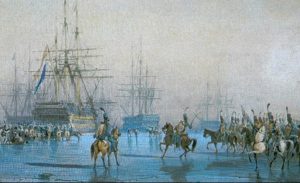 Ice flows in the world’s waterways has been known to freeze ships in place, leaving them stuck, often damaged, and sometimes…captured. The date was January 23, 1795, and the Dutch fleet was at anchor in the Zuiderzee, fifty miles north of Amsterdam. It was the height of the French Revolution, and the winter in the area was not cooperating with the fleet. In fact, some people in the port town of Den Helder said it was the worst winter they had seen in many years.
Ice flows in the world’s waterways has been known to freeze ships in place, leaving them stuck, often damaged, and sometimes…captured. The date was January 23, 1795, and the Dutch fleet was at anchor in the Zuiderzee, fifty miles north of Amsterdam. It was the height of the French Revolution, and the winter in the area was not cooperating with the fleet. In fact, some people in the port town of Den Helder said it was the worst winter they had seen in many years.
A unit of French soldiers was approaching the town that night, under the command of brigadier-general De Winter. Everyone in town knew it. A few days earlier, seven self-governing provinces had declared independence and a loose alliance. The old Republic had been ousted. Den Helder was now part of the newly declared Batavian Republic. Emotions were running high with excitement among the people, and the arrival of soldiers from the revolutionary new French Republic was welcomed. Having the Dutch Fleet in the port was oppressive, and they were ready for it to end. There was much talk of France, and of all that had been achieved there in recent years. The revolution was real, the monarchies had fled, and battles on sea and on land were being won. A bright future, free from the tyranny of the old leaders and old politics was within their grasp. The people felt hope again.
The only people who didn’t know about the French cavalry was the men on the Dutch fleet…not that it would have really mattered. It was almost midnight when the French detachment arrived. It was freezing, and the men were bundled in every garment they possessed…a great troop of horsemen riding double toward the port. People left the inns and public houses, cheering them on, and pointing out toward the Zuiderzee, where the Dutch fleet was anchored. The captain of the cavalry dismounted at the water’s edge…almost amazed. The reports were true. There, in the crisp light of the moon and stars he could see ships anchored in the bay, but he was looking not across the water. He was gazing across a great sheet of grey ice. The Zuiderzee, was shallow and fed by fresh water…and it had frozen over. The fleet in the bay was icebound and trapped. The fleet of the old Dutch Republic must have been sitting there for days, he said, but until yesterday its presence had been hidden from the town by fog and snow. Layers of snowfall had frozen and thickened the ice, which was now many feet deep.
After the scouts checked out the situation and returned, the Captain asked, “How many ships?” When he received his answer, he made his decision. This was too good a chance to miss. Messages were dispatched to General De Winter, and the soldiers were given their orders. They were to wrap the horse’s hooves in cloth, both to muffle the sound of their approach and to minimize the chance of the heavy hooves and steel horseshoes shattering the ice. They were to approach slowly and cautiously, and they were to be silent. They were to listen for the cracking of the ice, and be prepared to make an careful retreat if necessary. Onto the ice they went, horsemen and infantry, silent as the clouds of vapor that streamed from their mouths and noses as they breathed. There were eighty five warships and twenty merchant vessels trapped in the ice. The fleet represented most of the naval power of the deposed Dutch Republic, its capture would be a huge win for the French. As they advanced carefully across the ice, their ears strained for the creaking noises which would herald disaster. They became more confident. The ice held. They gathered speed. The dark ships growing larger as they came closer.
There were a few lights coming from the fleet, and the captain stopped his men short before they reached the first vessels. As quietly as possible, he sent men on foot in between the sides of the great ships. It took an hour for his men to survey the situation, and to identify the command vessel. This was a great 86 gunner, near to the French position. The captain gave his orders quickly and quietly. A detachment of horsemen was sent back, with orders to ride the shore of the Zuiderzee and establish exactly how far out the ice extended. Then, the captain dismounted and walked with the great body of his infantry round to the great command ship. They carried ropes and grappling hooks. The captain had his men prime their rifles, and then they threw hooks with ropes onto the ships.
At the sound of the first hooks on the deck a dozing watchman woke up. By the time he was awake enough to raise a cry, the captain and hundred men were on the deck. The watchman called out and ran toward the great bell, meaning to raise the alarm, but he slipped on the icy deck. There was a rush of feet, and he found himself staring up at the barrel of a musket. “Silence!” hissed the soldier. The command ship had been boarded. When the admiral was rousted from his bed and presented himself on deck, he knew that there was no hope of 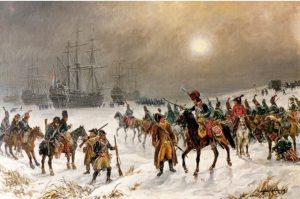 resistance. The conversation he had with the young French captain of the cavalry was courteous. There would be more French troops arriving at first light, and General De Winter would arrive with them. De Winter was now the master of the Dutch fleet, and he would give clear orders. The admiral had no choice, but to give orders that the fleet surrender. When De Winter arrived in the morning the whole fleet was secured and explored in the grey morning light. The captain of the cavalry was promoted on the spot, and the admiral and his crews swore allegiance to the French Republic. A great victory had been won, without a drop of blood spilled or a single shot fired. It was the only such event ever recorded in military history.
resistance. The conversation he had with the young French captain of the cavalry was courteous. There would be more French troops arriving at first light, and General De Winter would arrive with them. De Winter was now the master of the Dutch fleet, and he would give clear orders. The admiral had no choice, but to give orders that the fleet surrender. When De Winter arrived in the morning the whole fleet was secured and explored in the grey morning light. The captain of the cavalry was promoted on the spot, and the admiral and his crews swore allegiance to the French Republic. A great victory had been won, without a drop of blood spilled or a single shot fired. It was the only such event ever recorded in military history.
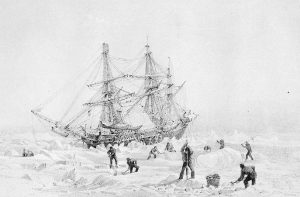 Modern day ships sailing the polar regions of our Earth have one distinct advantage over the much earlier counterparts…a radio. Radios wouldn’t be in place until 1899. The ships that sail these areas are trying to find new passages to cross the massive ice flows without having to sail far from their intended destinations in an effort to be in waters that are not frozen by the severe cold of the polar regions. When we think of ice, we rarely think of the shifting of the polar ice flows…or at least I didn’t really think of that. The changes in the day to day temperatures can create cracks in the ice, and the movement of the water below can either free a ship, or entrap it further, in an ever tightening squeeze hold that forces the crews to abandon the ship or risk being crushed to death when the ice moves again.
Modern day ships sailing the polar regions of our Earth have one distinct advantage over the much earlier counterparts…a radio. Radios wouldn’t be in place until 1899. The ships that sail these areas are trying to find new passages to cross the massive ice flows without having to sail far from their intended destinations in an effort to be in waters that are not frozen by the severe cold of the polar regions. When we think of ice, we rarely think of the shifting of the polar ice flows…or at least I didn’t really think of that. The changes in the day to day temperatures can create cracks in the ice, and the movement of the water below can either free a ship, or entrap it further, in an ever tightening squeeze hold that forces the crews to abandon the ship or risk being crushed to death when the ice moves again.
One such abandoned excursion was the case of the HMS Terror and the HMS Erebus. The ships were participating in Sir John Franklin’s ill-fated attempt to force the Northwest Passage in 1845, during which they were lost with all hands. Before leaving on the Franklin expedition, both Erebus and Terror underwent heavy modifications for the journey. They were both outfitted with steam engines, taken from former London and Greenwich Railway steam locomotives. The engines were rated at 25 horse power, and each could propel its ship at 4 knots. The pair of ships became the first Royal Navy ships to have steam-powered engines and screw propellers. The ships carried a twelve day supply of coal. Iron plating was added fore and aft on the ships’ hulls 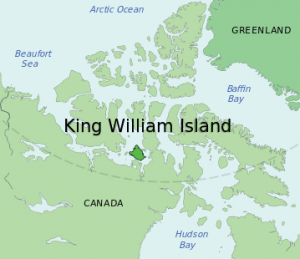 to make them more resistant to pack ice, and their decks were cross-planked to distribute impact forces. Along with Erebus, Terror was stocked with supplies for their expedition, which included among other items: two tons of tobacco, 8,000 tins of preserves, and 2,000 of liquor. Terror’s library had 1,200 books, and the ship’s berths were heated by ducts that connected them to the stove.
to make them more resistant to pack ice, and their decks were cross-planked to distribute impact forces. Along with Erebus, Terror was stocked with supplies for their expedition, which included among other items: two tons of tobacco, 8,000 tins of preserves, and 2,000 of liquor. Terror’s library had 1,200 books, and the ship’s berths were heated by ducts that connected them to the stove.
Sir John Franklin was in command of the expedition into the Artic in HMS Erebus, and Captain Francis Crozier was in command of HMS Terror. The expedition was tasked with gathering magnetic data in the Canadian Arctic and to complete a crossing of the Northwest Passage, which had already been charted from both the east and west, but never entirely navigated. The expedition was planned to last three years. The expedition sailed from Greenhithe, Kent, on May 19, 1845, and the ships were last seen entering Baffin Bay in August 1845. When the ships did not return at the appointed time,a massive search effort began in 1848 and again in 1866 in the Arctic. Eventually, enough evidence was found to reveal the circumstances of the expedition’s fate. Both ships had become icebound and had to be abandoned by their crews. Sadly, all 129 crew members died of exposure and starvation while trying to trek overland to Fort Resolution, a Hudson’s Bay Company outpost 600 miles to the southwest. Subsequent expeditions up until the late 1980s, including autopsies of crew members, revealed that their canned rations may have been tainted by both lead and botulism. Oral reports by local Inuit that some of the crew members resorted to cannibalism were at least somewhat supported by forensic evidence of 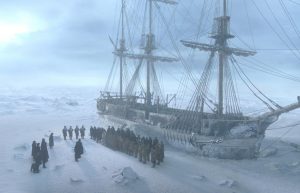 cut marks on the skeletal remains of crew members found on King William Island during the late 20th century.
cut marks on the skeletal remains of crew members found on King William Island during the late 20th century.
While crew members had been found over the years, the ships were not found for 169 and 171 years respectively. In 2014, the wreck of HMS Erebus was discovered, and on September 12, 2016, the Arctic Research Foundation announced that the wreck of Terror had been found ironically in Nunavut’s Terror Bay, off the southwest coast of King William Island. The wreck was discovered 57 miles south of the location where the ship was reported abandoned, and some 31 miles from the wreck of HMS Erebus.

